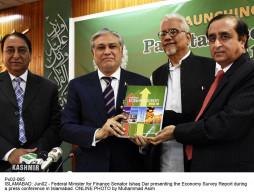
Pakistan’s economy has stabilised and is rebounding. That is a fact and to claim otherwise would be unwise. After coming to power in 2013, the government of Prime Minister Nawaz Sharif has brought about overall macroeconomic stability. Pakistan has entered the MSCI Emerging Markets Index, seen its debt ratings upgraded, and now has over $20 billion in foreign exchange reserves. According to the latest government statistics, the economy grew by 4.7 per cent and the country’s fiscal deficit fell to 3.4 per cent of GDP. So is Pakistan’s economy set to take off? The answer depends on what measures the government takes to convert short-term stability into long-term economic success.
For a government that boasts about its economic acumen, the recent decline in exports should be alarming. The finance minister would have everyone believe that the decline has to do with international headwinds. The reality is that the government has been unable to institute reforms that boost productivity, enhance Pakistan’s export competitiveness, and provide an ecosystem that facilitates export growth. From July 2015 to March 2016, Pakistan’s exports declined by 12.9 per cent to $15.6 billion. This paints a sorry picture and renders unattainable the government’s own target of $150 billion in export revenue by 2025.
Pakistan's economic outlook at six-year high
In recent months, the prime minister and his team have embarked on multiple international tours. The goal of these trips was to raise Pakistan’s profile, woo investors, and promote the government’s business and investor-friendly policies. Despite this, FDI inflows have not witnessed a remarkable increase. According to the State Bank of Pakistan, FDI inflows in 2015-16 grew by only 10.5 per cent to just over $1 billion. China contributed over half the inflows, investing $571 million during this period. While the China-Pakistan Economic Corridor has made headlines both locally and internationally, the government has been unable to capitalise on the positive headlines and failed to attract increased investments from other countries.
Pakistan’s narrow tax base has routinely contributed to the country’s numerous economic crises. The current government came to power with a mandate to widen the tax bracket and take measures to eliminate fiscal leakages. Despite the rhetoric, Finance Minister Ishaq Dar and his team have been unable to plug leakages and boost revenue collection. According to the latest data, tax exemptions led to a loss of almost Rs400 billion, which is 4.5 per cent less than the previous year. While this is a slight improvement, the devil is in the details. In June 2014, the government began withdrawing Statutory Regulatory Orders and has withdrawn Rs227 billion worth of exemptions. The government has also instituted amnesty schemes in a bid to widen the tax bracket. These measures should have led to a dramatic improvement in Pakistan’s revenue-generation capabilities, but that has not been the case. This is because these policies have shied away from substantial reforms, resulting in a tax-to-GDP ratio of under nine per cent.
Post-Brexit: What it means for the Pakistani economy
To meet its foreign currency needs, Pakistan has increasingly depended on remittances and raising external debt. Increased exports and FDI inflows are necessary if Pakistan is to sustainably meet its forex needs. Low oil prices and a favourable interest rate environment in the United States and Europe have given much-needed breathing space and allowed the country’s foreign reserves to recover. As the slump in oil prices ends and central banks in the United States and elsewhere tighten their monetary policy, Pakistan’s foreign exchange reserves and currency will face growing pressures. To counter against these headwinds, the government must institute bold reforms that raise export competitiveness and attract FDI outside of the Chinese inflows for CPEC.
Pakistan’s narrow tax base limits the government’s ability to spend on infrastructure, education, healthcare and social development. Investments in these areas are critical for sustained economic growth. Much has been written about the reforms that need to be instituted to widen the tax bracket and the country’s revenue generation capabilities. The issue persists not because there is a lack of policy prescriptions, but because there is a lack of political will.
With general elections not too far off now, it is highly unlikely that the government will take bold measures to plug fiscal leakages and go after tax evaders. Facing a turbulent political situation and the prospect of elections, Prime Minister Nawaz Sharif is unlikely to push for substantial tax reforms. Political impetus to take measures that seek to increase FDI inflows and boost export competitiveness can and should be taken. Over the last few months, the government has been promising to deliver on this front. One hopes that these words turn into action, and that Pakistan’s economy can sustain this nascent recovery.
Published in The Express Tribune, July 2nd, 2016.
Like Opinion & Editorial on Facebook, follow @ETOpEd on Twitter to receive all updates on all our daily pieces.




















































COMMENTS (4)
Comments are moderated and generally will be posted if they are on-topic and not abusive.
For more information, please see our Comments FAQ